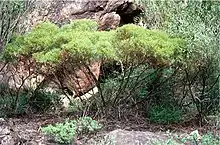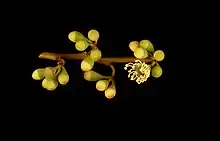| Twin Peak Island Mallee | |
|---|---|
 | |
| Eucalyptus insularis growing at Cape Le Grande | |
| Scientific classification | |
| Kingdom: | Plantae |
| Clade: | Tracheophytes |
| Clade: | Angiosperms |
| Clade: | Eudicots |
| Clade: | Rosids |
| Order: | Myrtales |
| Family: | Myrtaceae |
| Genus: | Eucalyptus |
| Species: | E. insularis |
| Binomial name | |
| Eucalyptus insularis | |
Eucalyptus insularis, commonly known as Twin Peak Island mallee,[2] or North Twin Peak Island mallee,[3] is a species of mallee that is endemic to a small area of southern Western Australia. It has mostly smooth bark, dull green, linear adult leaves, flower buds in group of between nine and twenty or more, white flowers and barrel-shaped fruit.


Description
Eucalyptus insularis is a mallee that typically grows to a height of 1.5 to 8 metres (5 to 26 ft) and forms a lignotuber. It has smooth greyish bark, sometimes with rough, fibrous bark on larger stems. Young plants and coppice regrowth have sessile, oblong to lance-shaped leaves 35–55 mm (1.4–2.2 in) long and 8–15 mm (0.31–0.59 in) wide arranged in opposite pairs. Adult leaves are arranged alternately, the same dull green colour on both sides, linear in shape, 28–55 mm (1.1–2.2 in) long and 4–7 mm (0.16–0.28 in) wide on a petiole 4–8 mm (0.16–0.31 in) long. The flower buds are arranged in leaf axils in groups of between nine and twenty or more on a pendulous peduncle 3–8 mm (0.12–0.31 in) long, the individual buds on pedicels 2–4 mm (0.079–0.157 in) long. Mature buds are oval, 4–6 mm (0.16–0.24 in) long and 2–3 mm (0.079–0.118 in) wide with a rounded to conical operculum. Flowering occurs in August and the flowers are white or creamy white. The fruit is a woody, barrel-shaped capsule 7–8 mm (0.28–0.31 in) long and 5–6 mm (0.20–0.24 in) wide with the valves near rim level.[2][3][4][5]
Taxonomy and naming
Eucalyptus insularis was first formally described in 1974 by Ian Brooker from a specimen collected on North Twin Peak Island in the Recherche Archipelago and the description was published in the journal Nuytsia.[5][6] The specific epithet (insularis) is a Latin word meaning 'of an island', referring to the location of the type specimen.[3]
In 2014, Dean Nicolle and Ian Brooker described two subspecies of E. insularis and the names have been accepted by the Australian Plant Census:[7]
Distribution and habitat
The Twin Peak Island mallee grows in closed shrubland and heath near granite outcrops. Subspecies continentalis is only known from two or three populations on the mainland in the Cape Le Grand National Park and subspecies insularis only grows on North Twin Peak Island.[7]
Conservation status
Twin Peak Island mallee is listed as "endangered" under the Australian Government Environment Protection and Biodiversity Conservation Act 1999.[10]
Subspecies continentalis is listed as "Threatened Flora (Declared Rare Flora — Extant)" by the Department of Environment and Conservation (Western Australia).[11] Subspecies insularis is listed as is classified as "Priority Four",[12] meaning that is rare or near threatened.[13] The main threat to the species is increasing fragmentation and loss of remnant populations.[10]
See also
References
- ↑ "Eucalyptus insularis". Australian Plant Census. Retrieved 31 July 2019.
- 1 2 "Eucalyptus insularis". FloraBase. Western Australian Government Department of Biodiversity, Conservation and Attractions.
- 1 2 3 "Eucalyptus insularis". Euclid: Centre for Australian National Biodiversity Research. Retrieved 1 June 2020.
- ↑ Chippendale, George M. "Eucalyptus insularis". Flora of Australia. Australian Biological Resources Study, Department of the Environment and Energy, Canberra. Retrieved 31 July 2019.
- 1 2 Brooker, M. Ian H. (1974). "Six new species of Eucalyptus from Western Australia". Nuytsia. 1 (4): 308–310. Retrieved 31 July 2019.
- ↑ "Eucalyptus insularis". APNI. Retrieved 31 July 2019.
- 1 2 3 Nicolle, Dean; Brooker, M. Ian H.; French, Malcolm E. (2014). "A new subspecies of the threatened moncalypt Eucalyptus insularis (Myrtaceae) from Western Australia" (PDF). Nuytsia. 24: 249–253. Retrieved 31 July 2019.
- ↑ "Eucalyptus insularis subsp. continentalis". Australian Plant Census. Retrieved 31 July 2019.
- ↑ "Eucalyptus insularis subsp. insularis". Australian Plant Census. Retrieved 31 July 2019.
- 1 2 "Approved Conservation Advice for Eucalyptus insularis (Twin Peak Island Mallee)" (PDF). Australian Government Department of the Environment. Retrieved 31 July 2019.
- ↑ "Eucalyptus insularis subsp. continentalis". FloraBase. Western Australian Government Department of Biodiversity, Conservation and Attractions.
- ↑ "Eucalyptus insularis subsp. insularis". FloraBase. Western Australian Government Department of Biodiversity, Conservation and Attractions.
- ↑ "Conservation codes for Western Australian Flora and Fauna" (PDF). Government of Western Australia Department of Parks and Wildlife. Retrieved 31 July 2019.
